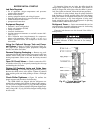
54
2. On low-voltage compressors (600 v or less) connect a
voltmeter across the power wires to the compressor start-
er and measure the voltage. Compare this reading to the
voltage rating on the compressor and starter nameplates.
3. Compare the ampere rating on the starter nameplate to
rating on the compressor nameplate. The overload trip
amps must be 108% to 120% of the rated load amps.
4. The starter for a centrifugal compressor motor must
contain the components and terminals required for PIC II
refrigeration control. Check the certified drawings.
5. Check the voltage to the following components and
compare it to the nameplate values: oil pump contact,
pumpout compressor starter, and power panel.
6. Ensure that fused disconnects or circuit breakers have
been supplied for the oil pump, power panel, and
pumpout unit.
7. Ensure all electrical equipment and controls are properly
grounded in accordance with job drawings, certified
drawings, and all applicable electrical codes.
8. Ensure the customer’s contractor has verified proper op-
eration of the pumps, cooling tower fans, and associated
auxiliary equipment. This includes ensuring motors are
properly lubricated and have proper electrical supply and
proper rotation.
9. For field-installed starters only
, test the chiller compres-
sor motor and its power lead insulation resistance with a
500-v insulation tester such as a megohmmeter. (Use a
5000-v tester for motors rated over 600 v.) Factory-
mounted starters do not require a megohm test.
a. Open the starter main disconnect switch and follow
lockout/tagout rules.
b. With the tester connected to the motor leads, take
10-second and 60-second megohm readings as
follows:
6-Lead Motor
— Tie all 6 leads together and test
between the lead group and ground. Next tie the
leads in pairs: 1 and 4, 2 and 5, and 3 and 6. Test
between each pair while grounding the third pair.
3-Lead Motor
— Tie terminals 1, 2, and 3 together
and test between the group and ground.
c. Divide the 60-second resistance reading by the
10-second reading. The ratio, or polarization
index, must be one or higher. Both the 10- and
60-second readings must be at least 50 megohms.
If the readings on a field-installed starter are unsat-
isfactory, repeat the test at the motor with the
power leads disconnected. Satisfactory readings in
this second test indicate the fault is in the power
leads.
NOTE: Unit-mounted starters do not have to be
megohm tested.
10. Tighten all wiring connections to the plugs on the ISM
and CCM modules.
11. On chillers with free-standing starters, inspect the power
panel to ensure that the contractor has fed the wires into
the bottom of the panel. Wiring into the top of the panel
can cause debris to fall into the contactors. Clean and in-
spect the contactors if this has occurred.
Carrier Comfort Network Interface —
The Carrier
Comfort Network (CCN) communication bus wiring is sup-
plied and installed by the electrical contractor. It consists of
shielded, 3-conductor cable with drain wire.
The system elements are connected to the communication
bus in a daisy chain arrangement. The positive pin of each sys-
tem element communication connector must be wired to the
positive pins of the system element on either side of it. The
negative pins must be wired to the negative pins. The signal
ground pins must be wired to the signal ground pins. See instal-
lation manual.
NOTE: Conductors and drain wire must be 20 AWG
(American Wire Gage) minimum stranded, tinned copper.
Individual conductors must be insulated with PVC, PVC/
nylon, vinyl, Teflon, or polyethylene. An aluminum/polyester
100% foil shield and an outer jacket of PVC, PVC/nylon,
chrome vinyl, or Teflon with a minimum operating tempera-
ture range of –4 F to 140 F (–20 C to 60 C) is required. See
table below for cables that meet the requirements.
When connecting the CCN communication bus to a system
element, a color code system for the entire network is recom-
mended to simplify installation and checkout. The following
color code is recommended:
Check Starter
Use the instruction and service manual supplied by the start-
er manufacturer to verify the starter has been installed correct-
ly, to set up and calibrate the starter, and for complete trouble-
shooting information.
If the motor starter is a solid-state starter, the motor leads
must be disconnected from the starter before an insulation
test is performed. The voltage generated from the tester can
damage the starter solid-state components.
MANUFACTURER CABLE NO.
Alpha 2413 or 5463
American A22503
Belden 8772
Columbia 02525
SIGNAL TYPE
CCN BUS
CONDUCTOR
INSULATION
COLOR
CCN TERMINAL
CONNECTION
+ Red RED (+)
Ground White WHITE (G)
– Black BLACK (–)
BE AWARE that certain automatic start arrangements can
engage the starter. Open the disconnect ahead of the starter
in addition to shutting off the chiller or pump.
The main disconnect on the starter front panel may not
deenergize all internal circuits. Open all internal and
remote disconnects before servicing the starter.


















